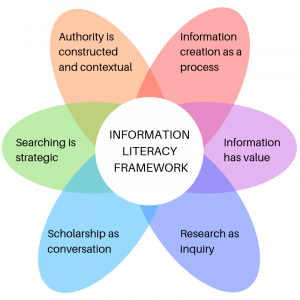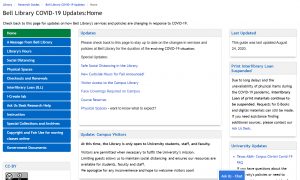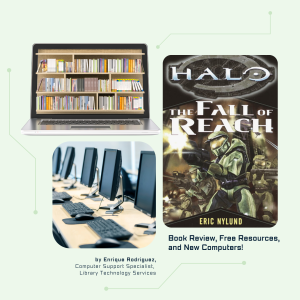Something that may surprise you is that I, a librarian, love social media. As librarians, we often tell students to shy away from social media and find “credible” and “scholarly” sources. But that doesn’t mean I don’t love watching TikToks or creating content for my puppy’s Instagram account. Social media can be fun. It can create a sense of community and make us feel good about ourselves. We can also learn new things from our friends and the people we follow.
But why then do we encourage students to look beyond social media to find the answers to their questions? While we can learn things from social media (#ILearnedItOnTikTok), social media platforms have also been known to spread misinformation, and fast.
Social media platforms are created using both persuasive and participatory design principles. They are designed to increase our time spent on and engaging with the application. We are motivated to participate with the application, and our participation is rewarded when we receive likes, comments, and retweets from others. It’s easy to like, share, and retweet within these platforms. And the prompts encourage us to click further into the app (as I was writing this sentence, I received a TikTok push notification that made me REALLY want to open the app).
When we use these platforms, we are in a different headspace than when we are doing research for a paper. We are less critical of the information we receive and are less likely to fact check the information before we interact with it. For example:
Have you ever shared a funny meme with a friend? Or have you liked an article that popped up on your timeline, solely based on the headline? Have you ever liked a TikTok that makes a claim before fact checking the claim? Have you ever tweeted about something because it was #trending?
The truth is, even as a librarian, I have done everything on this list. As someone who uses multiple social media platforms, I am a participant in this landscape. And while I may not be purposely sharing misinformation, I am also not fact-checking everything I share. So, for both you and for me, here are some things to think about before we:
- Share that meme: Memes are funny and are not meant to be taken seriously. They are created as an inside joke for a specific community. For example, the cover meme for this blog post may be funny for those who use Facebook and libraries, but maybe not funny for those outside of those communities. Memes are a great tool to use when expressing a common experience within a community. But there is also evidence that misinformation can spread through memes. For example, political messages can reach a wider audience of people when communicated via meme. While inherently that is not a bad thing, what happens when that message is spreading misinformation? For example, there are memes that joke about climate change being fake, and the Covid-19 vaccine making recipients magnetic.
- Like that Headline: Headlines are meant to be engaging and get our attention and can often help summarize the point of an article. But headlines can also lead to the spread of misinformation, because people often will only read the headline. (For example, did you just read the full text of the article I linked to? If you did, you may have noticed something quite funny). Research has found that when people can engage with a post (such as liking or upvoting), then they are less likely to read the full post, and instead selectively read what reflects their own views. Other research has found that people are more likely to share a post if it aligns with their views, and less likely to check for accuracy.
- Like that TikTok: TikTok is engaging because we can receive quick bits of digestible information at rapid fire. The algorithm also only shows you content that it suspects you will engage with. TikTok is great for learning new things, but it also can be a way for misinformation to spread about health and global events. The algorithm also makes it so you only may see one side of an argument, and so you typically are only getting one side of the story on your FYP.
- Join the #trending conversation: The trending section on Twitter is a great place to learn more about current events as they are unfolding. While it is a great feeling to be in-the-know, keep in mind that the trending section is often showing you tailored results. Also, keep in mind, just because it is trending doesn’t mean it’s true. In fact, sometimes rumors spread faster than truths, because we tend to be surprised by the gossip. For example, Harambe became a trending conversation after the 2016 election, when one person tweeted that the gorilla had received 11,000 write in votes for president. This has since been proven false by third-party fact checkers, but it didn’t stop it from going viral.
I hope this blog post helps you to think more critically about how you interact with the social media landscape. Keep on Tweeting on, but now we can do so more responsibly.
Hyperlinks:
Vox. (2019, October 8). Why do memes matter? – Glad you asked S1 [Video]. YouTube. https://www.youtube.com/watch?v=bYJZA86dPEo
SP Team. (2018, March 5). Study: 70% of Facebook users only read the headline of science stories before commenting. The Science Post. http://thesciencepost.com/study-70-of-facebook-commenters-only-read-the-headline/.
Pennycook, G., Z. Epstein, M. Mosleh, A. A. Arechar, D. Eckles, and D. G. Rand. (2021). Shifting attention to accuracy can reduce misinformation online”. Nature, 592(7855), 590-5. https://doi.org/10.1038/s41586-021-03344-2 .
Sude, D.J., Pearson, G.D.H, and Knobloch-Westerwick, S. (2021). Self-expression just a click away: Source interactivity impacts on confirmation bias and political Attitudes. Computers in Human Behavior, 114, 106571. https://doi.org/10.1016/j.chb.2020.106571 .
Smith, B. (2021). How Tiktok reads your mind. The New York Times, The New York Times. https://www.nytimes.com/2021/12/05/business/media/tiktok-algorithm.html.
Thompson, S. A., and Alba, D. (2022). Fact and mythmaking blend in Ukraine’s information war. The New York Times, The New York Times. https://www.nytimes.com/2022/03/03/technology/ukraine-war-misinfo.html.
Twitter. (n.d.). Twitter Trends FAQ. Retrieved March 9, 2022, from https://help.twitter.com/en/using-twitter/twitter-trending-faqs
Graves, A. (2016, November 22). No, 15,000 people did not vote for Harambe in 2016. Politifact. https://www.politifact.com/factchecks/2016/nov/22/blog-posting/no-15000-people-did-not-vote-harambe/


